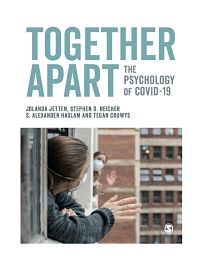Collective Trauma Amid COVID: Excerpt from ‘Together Apart’
A traumatic event is one in which a person experiences a genuine fear of death or injury for themselves or others. However, psychological symptoms in response to extreme and traumatic experiences are not unusual, and are captured under the umbrella term of post-traumatic stress (PTS). These can include disturbing thoughts and feelings long after the traumatic event has ended, feelings of detachment from others, hypervigilance to threat, and avoidance of reminders of the traumatic event. If symptoms are sufficiently intense and long-lasting, this may warrant a clinical diagnosis of post-traumatic stress disorder (PTSD).
While a substantial minority of people experience intense post-traumatic symptoms, what is sometimes overlooked is that most people are robust in the face of traumatic experiences and display psychological resilience. Though COVID-19 is a traumatic event likely to cause widespread PTS, group-based processes can play a key role in mitigating the severity of this and ensuring a more resilient response. This is particularly likely to be the case when the traumatic experience that people face is a collective experience such as COVID-19. Unlike a traumatic event such as assault, with COVID-19 the threat to life and safety is common to us all. Indeed, it is precisely because ‘we are all in this together’ that the collective curse of the virus could potentially pave the way to a collective cure — notably through people overcoming challenge by banding together.
The trauma of COVID-19 is amplified by social disconnection
It is clear that a pandemic fits the definition of a traumatic event, in so far as it threatens people’s lives and the lives of others they care about. Furthermore, there is evidence from previous disease outbreaks that such crises are widely perceived as traumatic. For instance, a review of the psychological impact of the 2003 SARS outbreak found consistent evidence that those affected experienced high levels of distress, and that this persisted for many years afterwards (Gardner & Moallef, 2015).

The requirement for people to self-isolate during the COVID-19 crisis is also likely to make it more traumatic. As discussed in previous chapters, this is because isolation disconnects people from each other and from meaningful groups that are a source of key social resources (e.g., social support; Haslam, Jetten et al., 2018). There is evidence that quarantine measures amplify people’s distress and compound the traumatic effects of an epidemic. For example, one study examined hospital employees in Beijing who were quarantined in 2003 due to SARS (Bai et al., 2004). It found that having been quarantined was the most important predictor of PTS symptoms. Similarly, adults and children who were quarantined due to SARS or the H1N1 outbreak in 2009 subsequently showed amplified levels of PTS symptoms (Braunack-Mayer et al., 2013). Another study indicated that the length of quarantine during the SARS outbreak also mattered. Specifically, those who were quarantined for more than 10 days were more likely to show PTSD symptoms than those quarantined for shorter periods (Hawryluck et al., 2004).
Group membership affects who is most vulnerable to traumatic stress in a pandemic
COVID-19 has connected the global community in an unprecedented fashion. While it is true that we are all in this together, the reality of the pandemic is that some groups are far more vulnerable than others. Indeed, group membership is a critical determinant of people’s experience of the COVID-19 crisis — not only psychologically, as has been the focus of this volume, but also structurally. For instance, life in 2020 will be vastly different if you are a nurse rather than an academic, a New Yorker rather than a New Zealander, or aged 80 rather 20. Moreover, those who cannot afford the luxuries of physical distancing, self-isolation or even running water and soap are made infinitely more vulnerable (Chung et al., 2020).
In many regards, these group-based realities mean that preventive actions are luxuries only those who live in more privileged circumstances can afford (in ways that we unpack further in Chapter 17). So, while the relatively well-off ‘romanticise’ the experience of quarantine (joking about their progress in learning to bake bread), others have to work in unsafe conditions where they cannot engage in physical-distancing behaviours, or are in forced detainment where they cannot escape others. For the latter groups, not being able to self-isolate during a global pandemic may be especially traumatizing. For those who cannot enact recommended safety behaviours or who are wilfully prevented from enacting them, advice to do so is alienating (see also Chapter 16 for how such experiences can lead to social disorder). Indeed, instructions to act in a way that is not feasible can increase anger and shatter a person’s faith and trust in the world — experiences that are known to exacerbate PTS. Likewise, feelings of betrayal by the health and political system (that a person may have previously trusted), strongly predict more severe and lasting PTS symptoms (Muldoon et al., 2019).
However, psychological group memberships, both existing and emerging in the face of COVID-19, also affect people’s vulnerabilities to traumatic stress. Indeed, when a person encounters a traumatic event they are not a “blank slate” but instead their response and ability to cope are shaped by their group memberships and the psychological resources that these provide. In this context, evidence suggests that the nature and number of a person’s prior group memberships are important for at least two key reasons. First, pre-existing group memberships offer a platform for developing new connections that are likely to be crucial in helping them negotiate trauma and traumatic situations (Kinsella et al., 2018). Second, those group memberships also provide group members with ongoing social connections that are the basis for social support as people negotiate trauma (Walsh et al., 2015). For example, people are more likely to find formal support services, such as counselling, more helpful when they are provided by others who are seen as ingroup members (Muldoon et al., 2019).
The collective nature of traumatic experience can support people’s resilience
Although the scale and severity of COVID-related trauma will vary along group-based lines, many aspects of the experience are shared among members of the groups to which people belong. As a result, many people will have a sense that this major upheaval is a collective one, to be tackled collectively.
This is important because research suggests that the sharedness of traumatic experience is an important factor in mitigating the distress and anxiety that these events create (Kearns et al., 2017). In particular, a sense of shared experience can contribute to feelings of collective efficacy (e.g., a shared perception that a community’s collective efforts to flatten the curve are working). This in turn is likely to contribute to psychological resilience. Support for this hypothesis emerges from several lines of research. For example, in survey work among Nepalese survivors of a major earthquake, an emergent sense of identity with the devastated community was the basis for an enhanced sense of collective efficacy that predicted increased resilience (Muldoon et al., 2017). Furthermore, experimental work confirms that responses to a stressful situation are often driven by a shared understanding of the situation, and that this understanding has the power to suppress a physiological stress response in the face of challenge (Haslam & Reicher 2006). Similarly, shared understandings of a traumatic situation have also been shown to attenuate its perceived stressfulness (Gallagher et al., 2014).
In short, a wealth of previous work suggests that there are likely to be multiple pathways through which group memberships will support people’s resilience in the face of COVID-19. In particular, there is reason to believe that groups and associated social identities — both those which existed before the virus and those which have arisen as a result of the virus — will prove to be a key resource in mitigating the impact of traumatic stress. As Rebecca Solnit (2020) suggests in the article we quoted at the start of this section, one of the significant consequences of the pandemic has been the ability to appreciate anew not only the strength of our collective ties, but also their capacity to help us transform catastrophe into courage.
Explore the section of Together Apart on social (dis)connectedness
Group Threat and COVID| Katharine H. Greenaway
Risk Perception Amid COVID | Tegan Cruwys
Social Isolation Amid COVID | Sarah V. Bentley





















































































An interesting perspective on how resiliency is impacted. Thank you.